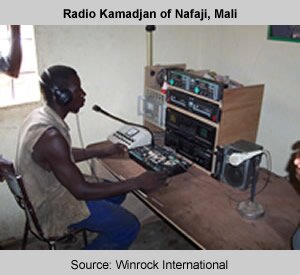Broadcast Radio
Home > THE BASICS> ICT Options > TV and Radio > Broadcast Radio
Power is needed for both radio receivers and small community radio broadcasting stations based in remote, off-grid communities. In 1999, WorldSpace introduced satellite radio broadcasting in Africa, providing a source of information to many rural and remote areas for the first time. On the ground, hundreds of community radio stations have been established over the past 15 years to serve isolated rural communities. The radio stations play an important role in the economic and social life of the communities by bringing news of local happenings, education and entertainment to listeners in their own language. Many portable radios, WorldSpace satellite radio receivers and tape recorders are designed to operate with both DC and AC, using “D”, “C” or “AA” size dry batteries. The cost of replacing the dry batteries is very high, even when compared to the cost of solar energy. It is feasible to power any radio or tape recorder with a PV system. This is done by connecting cables to the appropriate terminals in the compartment that normally houses the batteries. This is not a very elegant solution, but it is a more efficient and less costly way of operating a radio or tape recorder with a PV system. The voltage required by these devices can range from 3 to 12 V, depending on the model. There are low cost converters that produce a variable voltage from 12 V for this purpose. Power consumption for a portable, double speaker radio/tape recorder rarely exceeds 20 W at full volume and with the cassette player in operation. A consumption of 8 to 12 W is more typical. If only the radio is used at a moderate volume, consumption can be as low as 3 or 4 W. A CD-player/boom box might consume 25 W. Community radio stations may require several kilowatt-hours of power in order to broadcast 24 hours per day and maintain radio station operations in remote areas. Although the energy demand of a commercial radio station can be much higher than the 2-3 kW peak loads addressed in this guidebook, some small community radio stations with limited areas of coverage may operate within this range. Related Web-based Resources Related Case Studies |
